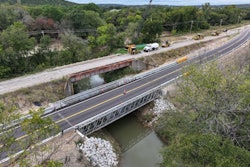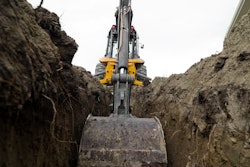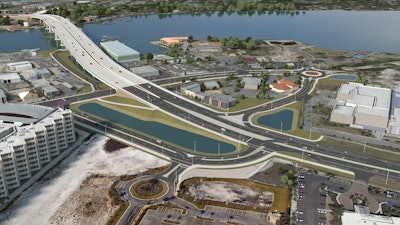
The contractor and designer for a new bridge being constructed in Florida expect it to be a showpiece design, accommodating a sensitive yet harsh environment while also marking a first in the U.S. for a corrosion-resistant post-tensioning method.
The John T. Brooks Bridge between Fort Walton Beach and Okaloosa Island was built in 1965 and handled about 1,500 vehicles a day in its early days. Today, traffic has increased to 66,000 vehicles daily on the four-lane U.S. 98 span over the Santa Rosa Sound and Intracoastal Waterway. It’s also too low to accommodate larger boats, and there have been strikes. In 2013, a barge hit the bridge, which also carries utilities to Okaloosa, knocking out water service to the island.
The Florida Department of Transportation has selected the design-build team of Superior Construction and engineering firm WSP to demolish and replace the bridge with a wider, longer, taller, stronger, six-lane structure. The $171 million project will also feature biking and walking paths, drainage improvements, intersection upgrades and even special lighting to protect sea turtles.
“It's not just going to be a bridge,” says Matt Durshimer, WSP project design manager. “There are things that will make this an iconic structure unique to Fort Walton Beach and Okaloosa Island.
“There are things you won't see on other bridges in the state or in the country.”
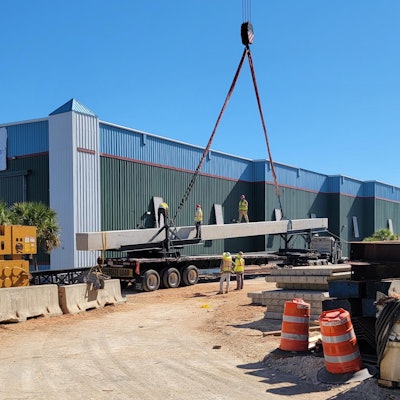 A 30-inch prestressed concrete “test” pile is being off-loaded to the work zone at the base of the Brooks Bridge on Okaloosa IslandMy Brooks Bridge Facebook page
A 30-inch prestressed concrete “test” pile is being off-loaded to the work zone at the base of the Brooks Bridge on Okaloosa IslandMy Brooks Bridge Facebook page
Wax In, Grout Out
Once completed, the new John T. Brooks Bridge will be the nation's first internal-tendon spliced-girder bridge to use unbonded flexible filler, according to WSP.
That means instead of using grout to cement in the post-tensioning tendons, which can over time be susceptible to corrosion, inspection and maintenance problems, the ducts that hold the tendons will be filled with wax to protect the strands from corrosion.
The wax is melted and injected into the duct. “The key thing is, now instead of having a void in the duct that was filled with grout, which provides structural performance, that duct is now filled with wax, and so it's hollow,” explains Durshimer. “So it changes the performance of that girder, because of what was previously solid concrete is now a hole on the girder.”
Durshimer says the method has been used frequently in Europe, and the Florida Department of Transportation has researched it thoroughly. FDOT has been incorporating it into projects because of its corrosion-resistance in the state’s harsh, salty climate.
“The mechanism of instead of using grout and now using wax specific to a post-tensioned splice girder bridge is what is, to the best of our knowledge, the first in the United States,” he says.
The bridge design takes the hollow ducts into account with a thicker web for the beams, from 8 inches to 9 inches thick.
“It still meets absolutely every design code, and every load rating requirement of the structure is achieved,” he says. “We're not sacrificing anything by doing that … It's a pretty well-engineered, well-understood mechanism of how to transfer the stresses.”
Evan Lawrence, Superior Construction division manager, says the contractor has used the wax on previous projects, but this will be its first time for this type of bridge. A specialty subcontractor has been hired for the work, he says.
Protecting Sea Turtles
Any bridge construction project in Florida’s environmentally sensitive waterways and marshes will face stringent requirements.
The Brooks Bridge project is no different and goes further with special lighting to protect the area’s sea turtles, whose nesting and hatching habits can be disrupted by artificial light.
The bridge’s lighting near the shoreline will be low intensity with an amber hue designed to not hinder turtles coming up to lay their eggs or hatchlings heading to the water, Durshimer says. The light poles will also be spaced closer together to illuminate the road but not emit sky glow that might disorient the turtles. Lights farther away from the shoreline will also be designed to reduce sky glow by being pointed downward to prevent light from spilling above the fixture.
Wary of Barges
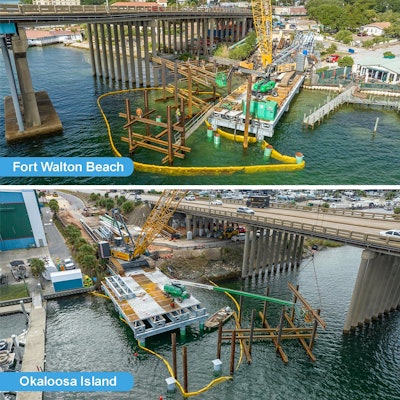 Both photos display construction of the temporary work trestle bridge platforms extending from land into the Santa Rosa Sound. The temporary trestle provides access for cranes and heavy equipment to reconstruct the bridge without the use of barges.Florida Department of Transportation, District Three
Both photos display construction of the temporary work trestle bridge platforms extending from land into the Santa Rosa Sound. The temporary trestle provides access for cranes and heavy equipment to reconstruct the bridge without the use of barges.Florida Department of Transportation, District Three
“We've designed the trestle with steel beams, steel pipe pile,” Lawrence says. “It's a very modular system that it is easy to take in and out as needed or switch around.”
He adds that there’s nothing to come loose. The company also has a hurricane plan.
“As soon as we know there's a storm coming through the Gulf, we start evaluating the sites, determining what needs to come off the trestle,” he says.
“It’s Very Tight … Very Challenging”
 Florida Department of Transportation, District Three
Florida Department of Transportation, District Three
The contract calls for an August 2027 completion date for the 2,111-foot bridge, which will be 793 feet longer than the current one.
To meet that deadline, Superior plans to build each end of the bridge simultaneously with two crews and work toward the middle and then back to the ends. The new eastbound bridge will be over the existing bridge’s footprint.
Blasting and full demolition is not planned. Because the new foundation is wider and longer than the current one, the existing foundations can be cut off at the mud line, Lawrence explains.
The most challenging part will be the first phase, as they work within the narrow right of way, which is about the same width as the cranes’ tracks.
“As we develop our beam-placement plan, it's a lot of steps along the way to make sure we don't block ourselves in with one of the cranes,” he says. “Because at some point, we have to pull these cranes off site, or they will just be stuck between the piers.
“It's very tight, it's very challenging, working near businesses and working around the existing structures.”
“This Job Has It All”
 WSP
WSP
“This job really helps connect the community between Fort Walton Beach and Okaloosa Island,” Lawrence says. “This is going to be iconic for the area with the pedestrian improvements, the access, how people perceive this project. I'm glad to be a part of that.”
Along with the new spans, highlights of the project include:
- Increasing the vertical clearance over the waterway from 50 to 65 feet to meet current Coast Guard regulations.
- Improving intersections from Perry Avenue (west of the Fort Walton Beach shore) to Pier Road (east of the Okaloosa Island shore).
- A new roundabout.
- Extending the bridge past the U.S. 98/Santa Rosa Boulevard intersection, so traffic can flow and eliminate the need for the traffic signal.
- Improving drainage, including new stormwater retention ponds.
- Upgrading intersections approaching the bridge to comply with Americans with Disabilities Act requirements.
- Constructing 12-foot-wide shared-use paths on each side of the bridge, to include scenic outlooks and shade structures. The paths will be separated from the road by protective barrier walls.
- Constructing 10-foot-wide inside and outside shoulders.
- Build new recreational area and parking beneath the bridge.
- Transferring all of the utilities on the bridge – water, sewer, communications, etc. – to the new bridge.
“This is is shaping up to be an opportunity for a landmark project,” says Durshimer, “a capstone project for what design-build can bring to both the owners, to the community as a whole – the amount of stakeholder coordination done with state and federal agencies to meet all their expectations for the project.”
“This job has it all,” he adds. “… In terms of embodying civil engineering and civil construction into one, this project has it.”
For a virtual tour of the future Brooks Bridge, check out the video below:



